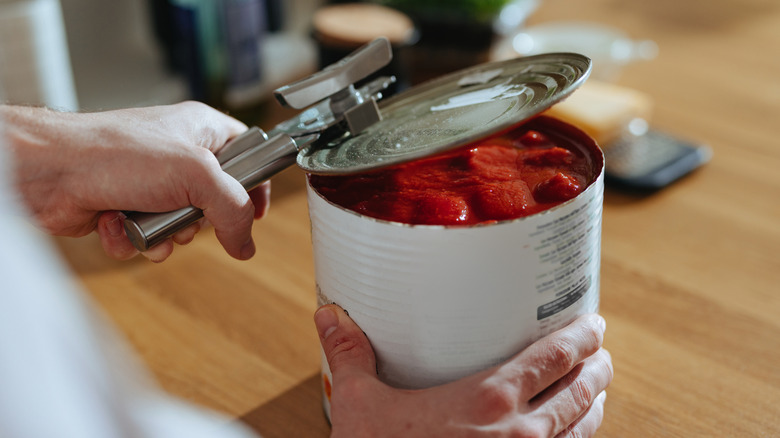The Simple Trick To Reduce Sodium From Canned Vegetables
Like them or hate them, everyone needs to eat more vegetables. Vegetables are a low-calorie source of fiber, vitamins, minerals, and phytonutrients that reduce your risk of chronic conditions like high blood pressure, high cholesterol, type 2 diabetes, and obesity. Although your nutritional needs vary according to your age and other factors, most people need at least 2.5 cups of vegetables a day. That's quite a lot of produce to fill your refrigerator, and that's also assuming your favorite vegetables are in season.
Although canned vegetables don't taste as good as fresh, you don't have to worry about spoiling unless it's been years since you've cleaned out your pantry (how long you can safely store canned food). Also, canned vegetables are always in season. However, one problem with canned vegetables is the amount of sodium needed to preserve them. You could try rinsing your vegetables to remove excess sodium, but an older study in the Journal of the American Dietetic Association says it might not work as well. Instead, the researchers replaced the canning brine in a can of green beans with tap water before heating the vegetables. This simple trick reduced the sodium in the green beans by 33%.
Lower the sodium, boost potassium
Most Americans get too much sodium in their diets, and when you look at how much sodium is in a cup of canned green beans, you may understand why. A cup of green beans has 460 milligrams of sodium, even though it has just 36 calories and 3.6 grams of fiber. To balance sodium levels in your body, you need potassium. Those green beans have 222 milligrams of potassium, which won't do much for your sodium-to-potassium ratio. For good health, you should choose foods with a sodium-to-potassium ratio below 1 (per Intake Health). Your can of green beans puts you above 2.
If you rinse and then cook these same green beans in fresh tap water, the sodium content could be reduced to 308 milligrams. That shaves the sodium-to-potassium ratio to 1.38. To improve the ratio, you may need to add more foods high in potassium to those green beans, such as cooked beet greens. Although beet greens also have sodium (347 milligrams), they have 1,309 milligrams of potassium per cup. Together, these two vegetables put you at a healthy 0.42 ratio.
Are canned vegetables healthy?
Canned vegetables retain most of their nutrients because they're often picked and canned at their peak. Some water-soluble vitamins, such as vitamins B and C, may be reduced because the canning process requires high heat. However, heating some vegetables, particularly tomatoes, can boost antioxidants like lycopene (per Academy of Nutrition and Dietetics). Just be sure to inspect your canned foods for denting, check their dates, and toss them if needed.
Canned vegetables are a low-cost option for those looking to trim their grocery budgets. Canned vegetables may also offer a convenient way to get more nutrition, according to a 2016 study in the Journal of the Academy of Nutrition and Dietetics. Adults who ate canned fruits and vegetables tended to have healthier diets overall, consuming more fiber, natural sugar, and potassium and less saturated fat compared to people who refrained from these canned foods. Both groups still consumed about the same amount of sodium and added sugar.
The American Heart Association suggests adding canned corn, tomatoes, and pinto beans to canned vegetable broth for a simple vegetable soup. Just look for low-sodium, reduced-sodium, or no-salt-added versions of these canned vegetables, and don't forget to rinse before cooking. Remember that canned fruits can often be drenched in added sugar, so choose canned fruits with water or juice.


